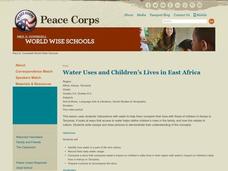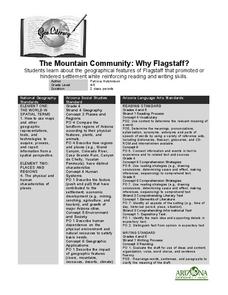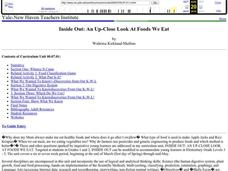Curated OER
The Web of Life - Ecosystem
Students examine the concepts of ecosystems and interdependence. They construct block pyramids to demonstrate interdependence, and map off an area to observe and identify animals. They create food chain mobiles and play a web of life game.
Curated OER
Common and Science Names
First graders investigate how dinosaurs are named. They listen to the book "The Littlest Dinosaurs," discuss Greek and Latin words and word parts, identify the word parts and meanings of Triceratops, and create a drawing of a dinosaur...
Curated OER
Tree Lesson
Learners compare and contrast characteristics of conifer and hardwood trees. After collecting samples of branches around the school, they classify the branch as hardwood or conifer. Groups of students identify given twigs. They go...
Curated OER
Succession in the Classroom
Middle schoolers investigate their environment by growing plants in class. In this botany lesson, students discuss the lifespan of plants and animals and how they must be cared for continuously over time. Middle schoolers grow a plant...
Curated OER
Limu in Your Lunch
Students explore various types of algae found in Hawaii. In this science lesson, students research species of the three types of limu and identify various uses. Students explore products that contain limu.
Curated OER
Buggy Diner
Students observe different insects and the different kinds of foods they like to eat. In this insects lesson plan, the teacher collects insects and different plants and roots. Then the students learn about those insects and have to be...
Curated OER
Water Uses and Children's Lives in East Africa
Learners identify how water use is part of life and culture. Students record their daily water usage and compare results with classmates. Learners complete the graphic organizer on water and children. Students compose an essay, which...
Curated OER
Erosion
Fifth graders study what erosion is, what causes it, and ways to slow its progress. They complete an experiment that depicts soil moving down a slope as water is poured on it to show how moving water erodes land. Next, they observe...
Curated OER
THE FARMER CARES FOR THE LAND
Students will identify cause and effect relationships in issues relating to Agriculture and the environment.Ask students to describe what farmers do. Then ask students to define the word "environmentalist." Ask students if they have...
Curated OER
Ocean Life
Students explore the types of plants and animals that can be found in the ocean. They browse books and/or magazines to identify and gain a knowledge base of plant and animal life found in the ocean, then create a collage.
Curated OER
It's All in the Rings
Students examine how the environment influences tree growth. In this tree instructional activity, students analyze the growth of rings to see how plants adjust to adverse conditions in order to survive.
Curated OER
Soil in My Food Web
Students explain the role of soil in the food web. In this agriculture lesson, students create a food web identifying how all items relate to soil, students play a game showing how interconnected the food web is, and they explain how...
Curated OER
Dinosaurs
Students research and identify the characteristics of a variety of dinosaurs. They participate in a class discussion about dinosaurs, analyze and examine fossils, and conduct research using a variety of sources to write and present a...
Curated OER
Science: Pigments and Photosynthesis
Young scholars explore the process of photosynthesis by identifying chloroplasts and chlorophyll pigments. In a demonstration, they observe a demonstration connecting pigments with sunlight conversion into energy. Using paper...
Curated OER
Writing Process
Fourth graders identify the benefits of using a field guide for nature observations. They then field trip to a natural setting to prepare for writing. They record their observations, and write a journal entry using the steps of the...
Curated OER
The Seasonal Round and The Cycle of Life
Students identify important dates in the life of the school and the community through reserach and interviewing. They identify important dates in the state and nation and research various holidays and special occasions. Students design...
Curated OER
Water Cycle Adventure
Students take an imaginary journey through the water cycle. In this water cycle lesson plan, students identify the various parts of the water cycle, listen while their teacher leads them on an imaginary journey through the water cycle,...
Curated OER
Fighting Soil Erosion
Students complete hands-on activities and watch a video to learn about soil erosion. In this erosion instructional activity, students use hands-on studies to investigate soil erosion. Students then visit the given websites to identify...
Curated OER
Fungi Crossword
In this biology worksheet, students complete a crossword puzzle with 28 questions about fungi. They identify the different parts of a fungus.
Curated OER
The Mountain Community: Why Flagstaff?
Students identify geographical features that hindered or promoted settlement in the city of Flagstaff, Arizona. In this settlement lesson plan, students write a summary of what they learned and identify geographical features on a map.
Curated OER
Animals and Environments
Students listen to stories and identify animals and their young. In this animals lesson, students view videos about farm animals and create illustrations to show how animal babies change over time. Students discuss how they care for...
Curated OER
Who's Who?
Students explore biology by identifying animals and their environments. In this animal characteristic instructional activity, students read assigned text about farm animals, how they are raised, and what they are used for in our society....
Curated OER
Inside Out: An Up-Close Look At Foods We Eat
Fourth graders identify the origins of meats and vegetables consumed by humans on a daily basis. They classify foods (meats, dairy products, grains...) and create a food pyramid.
Curated OER
Amazon Rainforest: You Won't Find George in This Jungle
Learners identify locations of rainforests, compare/contrast layers of the rainforest, construct and interpret maps and graphs, recognize relationships between man and the environment, and write about an imaginary walk in the rainforest.

























